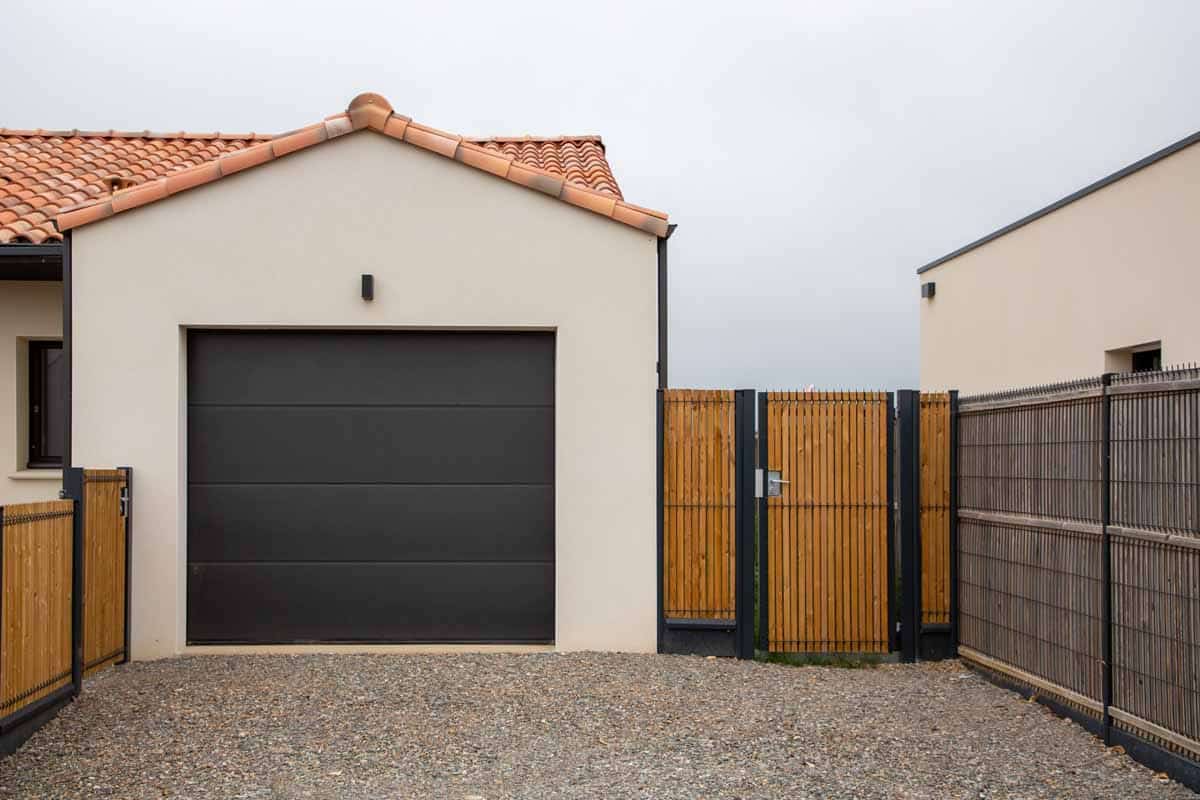Topics Covered:
We know firsthand how challenging it can be to optimize a small shop or garage space, especially when you need to accommodate motorcycles, scooters, ATVs, or any other compact ride. You want a door that’s big enough for easy access but not so large that it wastes valuable wall or ceiling space—after all, every square foot counts!
Why the Right-Sized Garage Door Matters
When space is at a premium—like in a single-bay garage or a dedicated motorcycle workshop—every decision you make about configuration can either open up more room or cut off potential storage and workflow areas. While a standard residential garage door might be 8 to 9 feet wide and 7 feet tall, that might be excessive (and unnecessarily costly) if you’re only parking motorcycles, mopeds, or similarly sized vehicles. Here’s why sizing matters so much:
- Optimized Space Usage: A door that’s too large can consume valuable wall space that could hold shelving, racks, or a workbench.
- Energy Efficiency: A smaller opening often equates to fewer drafts and less heat or cooling loss—important if you’re heating or cooling a compact workspace.
- Cost Savings: Generally speaking, smaller doors can be more affordable, both in initial purchase and potentially in long-term energy bills, depending on your setup.
- Easier Maintenance: Fewer moving parts and less panel area can mean simpler, quicker routine upkeep.
For many motorcycle owners or small-shop aficionados, the key is to choose a door that’s just big enough—no larger. This ensures you’re not cramping your interior but also not sacrificing easy entry or exit for your beloved bike.
Measuring Your Needs: Motorcycles, ATVs, and More
Before you explore door options, you need to clarify your space requirements. A standard motorcycle is roughly 7 feet long and about 2 to 3 feet wide (including handlebars). Many bikes have a height around 4 feet at the handlebars, though some custom rides might be taller. However, you also need walking clearance around the bike, and possibly space for added gear like saddlebags.
- Recommended Door Height: For motorcycles alone, a 6.5 to 7-foot-high door is often sufficient, though 7 feet is more common in residential systems. If you work with taller bikes or custom choppers with extended handlebars, aim for at least 7 feet to be safe.
- Recommended Door Width: A width of around 5 or 6 feet can be enough for a single bike entry—particularly if you’re only rolling one vehicle in. However, many people prefer at least 7 or 8 feet wide to comfortably maneuver a bike, push a rolling toolbox, or shift equipment in and out.
- Considering Multiple Bikes: If you plan to store two or more motorcycles side by side, factor in the total horizontal space. You might find that a single 8-foot-wide door is still enough if bikes are staggered or angled inside.
Motorcycles aren’t the only vehicles that could call a small shop home. ATVs, dirt bikes, or even small project cars might share space. Always measure your largest expected vehicle and add buffer room for comfortable access. A narrower door might require more careful maneuvering, which can become a hassle over time—especially when you just want to grab your bike and go for a quick ride.
Roll-Up vs. Sectional Doors: Which Is Better for Tight Spaces?
Two common door types for smaller shops are roll-up and sectional overhead doors. Each has pros and cons:
- Roll-Up Doors:
- Save Ceiling Space: Rolling into a barrel above the opening, they leave your ceiling largely free for lighting or storage racks.
- Compact Mechanism: Great for smaller widths, and often come in narrower custom sizes.
- Potentially Less Insulation: Basic roll-up models sometimes have limited insulation, although upgraded insulated versions do exist.
- Sectional Overhead Doors:
- Wide Range of Styles: You’ll find plenty of standard “single-bay” sizes and designs with better insulation or window panels.
- Flexibility in Materials: Steel, aluminum, or composite—plus more robust insulation is often available.
- Occupies Ceiling Space: The door travels along horizontal tracks overhead, which can limit ceiling storage or lighting placement.
For a small workshop, roll-up doors can be quite appealing if you’re short on ceiling space. Meanwhile, sectional doors might offer better insulation and aesthetics. The best choice hinges on your priorities: do you need maximum overhead clearance, or is top-notch insulation more critical?
Insulation Considerations: Smaller Doors Still Benefit
You might assume that a small door doesn’t need insulation—especially if you’re mostly storing a motorcycle or two. However, even a compact door can let in drafts, moisture, or extreme temperatures that cause discomfort for you and potential damage to your gear. Here’s why insulation is still worth it:
- Stable Indoor Temps: Insulated doors help keep the workshop cooler in summer and warmer in winter. This is especially helpful if you enjoy tinkering or performing maintenance on your motorcycle year-round.
- Moisture Control: Damp or humid air can cause metal surfaces to rust, corrode, or degrade over time. Insulation plus proper seals minimize moisture infiltration.
- Noise Reduction: If you occasionally rev your engine or run loud tools, insulation can cut down on noise that escapes to neighbors (and noise that enters from outside).
Look for polyurethane or polystyrene insulation if you want a decent R-value (insulation rating). A door with an R-value around 6 to 13 is often sufficient for moderate climate control in a small space. Double-check that your door’s seals—along the bottom, top, and sides—fit snugly to maximize insulation benefits.
Automation and Convenience
Even in a small garage, an automatic opener can significantly enhance convenience—no more manually lifting or wrestling with the door while balancing a bike. Consider the following features:
- Compact Openers: Some openers are specifically designed for limited overhead clearance or roll-up doors. These might mount on the wall beside the door track, freeing up ceiling space.
- Smartphone Integration: Newer openers let you check door status and open or close it from your phone. Great for ensuring you didn’t leave the door open if you’re away from home.
- Battery Backup: If your area experiences frequent power outages, a battery backup ensures you can still open and close the door—no need to revert to manual operation in the dark.
- High-Speed Motors: Although more common in commercial setups, high-speed openers can reduce the time you spend waiting for the door to clear, a plus if you often pop in and out for quick rides.
An automatic door can also add a layer of security. Not only do you avoid leaving a manual lock undone, but many modern openers have rolling-code technology that makes it harder for thieves to “grab” your door code.
Security Features for Your Bike and Gear
If you’re storing your prized motorcycle or valuable tools, you’ll want to ensure your small garage door has robust security. It might be a smaller target, but that doesn’t mean thieves won’t try. Key security features include:
- Durable Materials: Steel or aluminum doors with reinforced panels and frames are tougher to pry or kick in.
- Locking Mechanisms: Many openers feature automatic deadbolt locks that engage when the door closes, removing the human error factor. Manual slide bolts can be effective too—but only if you remember to engage them.
- Smart Alerts: Integrated door sensors can send notifications to your phone if the door is opened unexpectedly or left ajar.
- Motion-Activated Lights: External lighting near the garage door can deter criminals who prefer darkness.
With a small shop, you don’t have the luxury of hidden corners or multiple lock points. So it’s all the more critical that your door itself stands as a strong deterrent to would-be intruders.
Aesthetic and Design Choices
Your compact garage door doesn’t have to be purely utilitarian. Many manufacturers offer a range of styles—even at smaller sizes—so you can match the architectural look of your home or shop. You might consider:
- Window Inserts: A row of small windows at the top can let in natural light, reducing the need for constant artificial lighting. Just ensure they’re shatter-resistant for security.
- Color Options: Steel doors can be powder-coated in various shades, and fiberglass or composite materials might offer wood-grain finishes if you prefer a more rustic look.
- Decorative Hardware: Hinges, handles, or accent pieces can add a personal touch—great if your small shop doubles as a show space for your prized motorcycle.
Because the door is smaller, the cost of upgrades—like tinted windows or custom colors—can be more manageable than doing the same on a full-size two-car garage door.
Considering Layout: Getting the Most Out of Your Small Space
If you’re working with a tight footprint, the door’s placement within the wall can have a big impact on how you use the interior. Think about:
- Ceiling Clearance: A sectional overhead door with standard tracks might require 12 inches or more of headroom. If that’s a problem, you might opt for a low-profile track or a roll-up model that coils above the header.
- Side-Mount Options: Some openers can be installed on the side of the door, freeing the ceiling entirely. This can be a game-changer if you want a ceiling-mounted bike lift or heavy overhead storage for gear.
- Door Swing Path: If you’re moving motorcycles frequently, ensure you have enough room to roll them in without the door’s tracks or rails interfering. A poorly planned install can lead to awkward angles when parking inside.
Ideally, you want to be able to move freely from your bike to your workbench or tool area. Placing the door slightly offset might help create a more efficient path, especially if the rest of your shop is dedicated to gear storage or a small mechanical area.
Maintenance Routines for Small but Busy Doors
Even though your door is smaller, it can still see plenty of daily action. If you’re an avid motorcyclist who rides every day, or you frequently move small ATVs in and out, be prepared for a good number of cycles. Here’s how to keep your door in tip-top shape:
- Lubricate Hardware: Rollers, hinges, and springs benefit from routine lubrication—monthly or bimonthly if usage is high. This reduces friction and extends part life.
- Inspect Weatherstrips: Check the bottom seal and side seals for cracks or gaps. Replacing worn seals keeps out moisture and pests.
- Tighten Bolts and Screws: Vibrations from frequent door usage (and possibly from your bike’s revving) can loosen hardware over time.
- Check Opener Settings: If you have an automatic opener, ensure the force and travel limits are properly calibrated. A small door can suffer damage if the opener is set too forcefully.
These simple steps can significantly reduce the risk of annoying squeaks, jerky motion, or—worst of all—a stuck door when you’re ready to ride.
Cost and ROI: Is a Small Custom Door Worth It?
You might wonder if going for a specialized size or style will blow your budget. Generally, a smaller door can be cheaper than a standard-size door, but custom elements—like upgraded insulation, unique track configurations, or special finishes—can add to the cost. However, the benefits often justify the investment:
- Energy Savings: With less area to insulate and seal, you could see lower heating or cooling costs if your shop is climate-controlled.
- Time Saved: If you have an automatic opener or a door that’s perfectly sized for quick ins and outs, you save time daily—potentially worth a lot if you’re running a micro-business or frequently using the space.
- Better Space Utilization: A door that’s too large might restrict your interior layout. Tailoring the door size ensures you’re using every inch effectively for storage or workspace.
- Security and Protection: A well-built door keeps your bike and gear safe from weather and theft—priceless if you have a custom or high-end motorcycle.
So yes, it might be a bit pricier up front, but for many small shops, the return on convenience, efficiency, and peace of mind makes a custom-sized or high-quality door a very smart choice.
Real-World Case: A Raleigh Hobbyist’s Motorcycle Workshop
To illustrate how a right-sized door can transform a small space, let’s look at a recent local project. A hobbyist in Raleigh wanted a compact garage door for a 10×14 foot workshop, dedicated to storing and working on two motorcycles. He was tired of wrestling with a standard 8-foot-wide door that ate up all the interior ceiling space with its overhead tracks.
Our solution was a 6.5-foot-wide roll-up steel door with a low-profile barrel at the top. We added basic polyurethane insulation to keep the shop comfortable during mild winters. Here were the results:
- Increased Ceiling Space: The overhead coil left the ceiling open for a small bike hoist and overhead lighting.
- Easy Bike Entry: The 6.5-foot width was ample for a single motorcycle, plus some wiggle room—no more awkward angles or scraping handlebars.
- Enhanced Security: The door included an interior slide lock and automatic deadbolt, preventing tampering from outside.
- Better Workflow: The owner reports shaving several minutes off each session, no longer fiddling with a larger, heavier door or cluttered overhead tracks.
This relatively small install turned out to be a major quality-of-life improvement for that motorcycle enthusiast—and it wasn’t significantly more expensive than a generic solution. In fact, the final cost was comparable to many standard garage doors, but with major benefits in daily usability.
Final Thoughts
Whether you’re a dedicated motorcycle rider, a small-engine repair pro, or simply someone who needs to maximize space in a compact workshop, the right-sized garage door can bring enormous benefits. By carefully balancing dimensions, insulation, automation, and security, you’ll create a setup that’s effortless to use, protective of your prized gear, and space-efficient—letting you make the most of every square inch.
Here at RJ Garage Door Services in Raleigh, NC, we’re passionate about helping customers find perfect fits for their unique spaces. Whether it’s a standard single-bay door, a roll-up door for ultra-tight quarters, or a more custom solution, our team can guide you through measuring, selecting, and installing the best possible option. We’ll also ensure you know how to maintain your new door to keep it running smoothly for years to come.
If you’re ready to upgrade that too-big, too-slow, or too-drafty door—or just have a question about what sizes and features are available—please don’t hesitate to get in touch. We’re here to help you transform your small shop into a big-impact workspace that’s a joy to use every time you fire up your bike!




